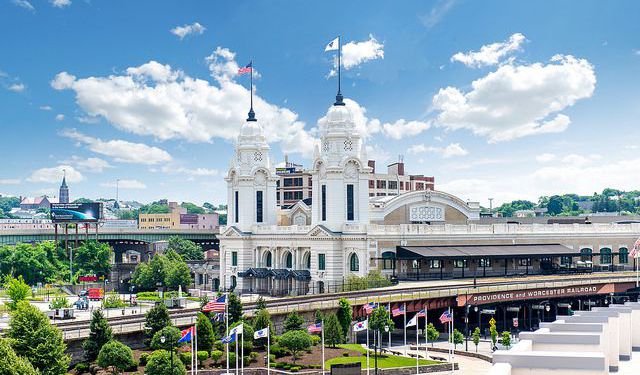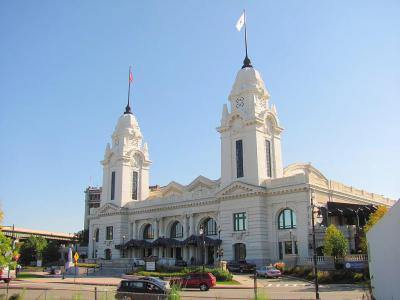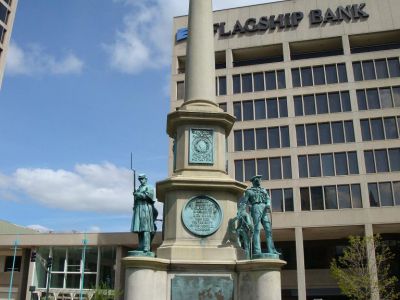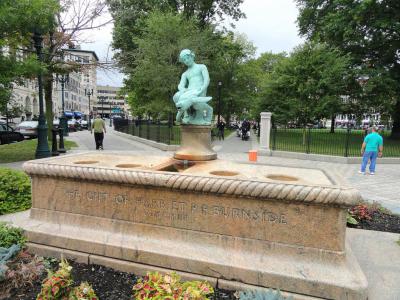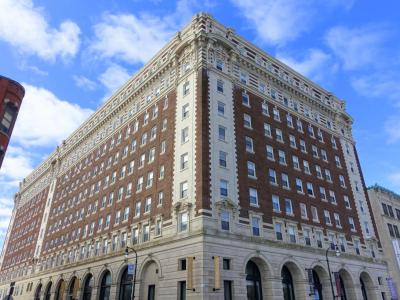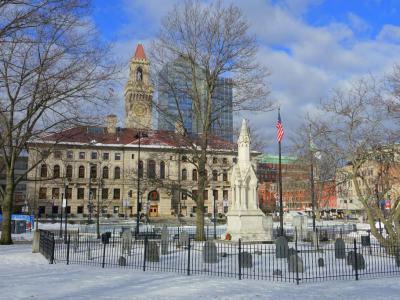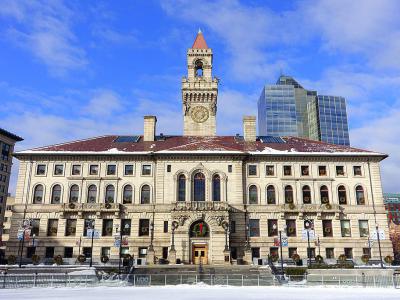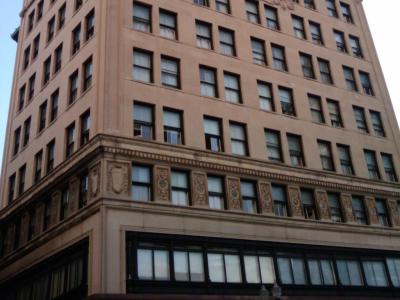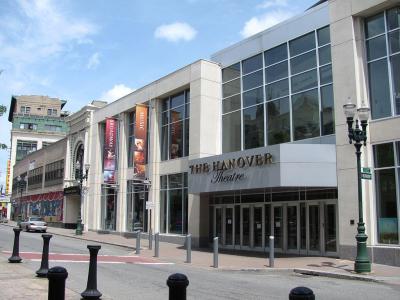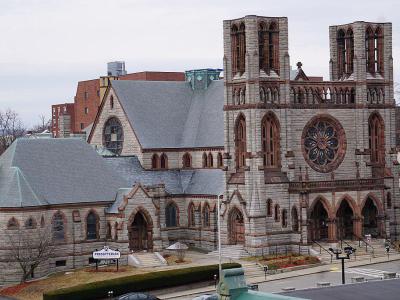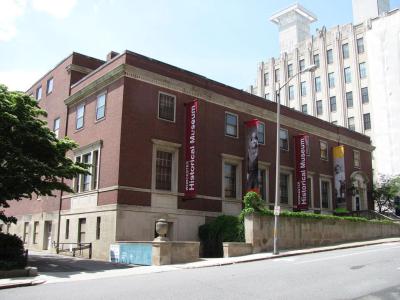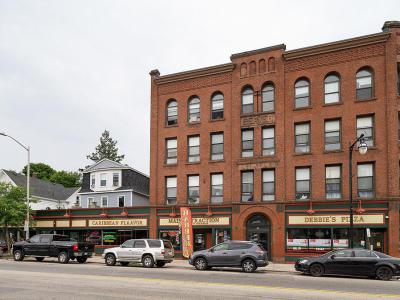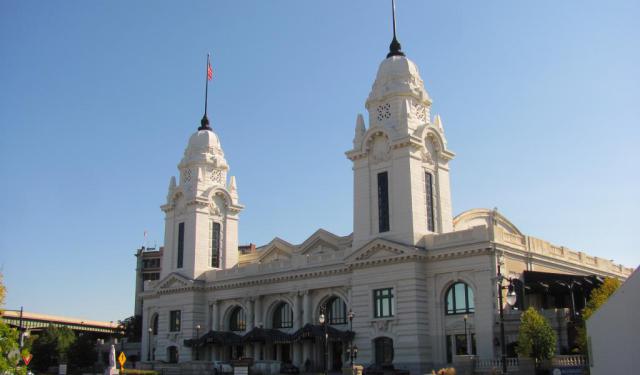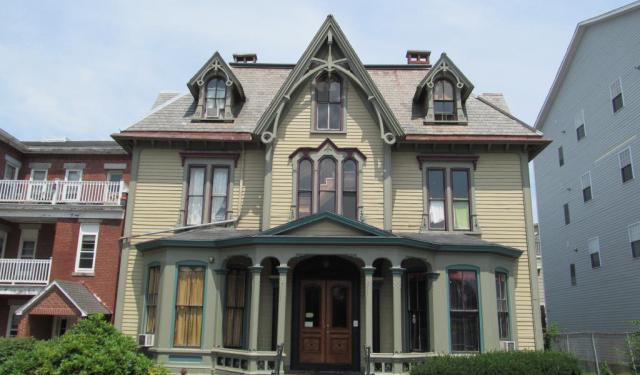Worcester Introduction Walking Tour (Self Guided), Worcester
Known as the "Heart of the Commonwealth," Worcester's central location in Massachusetts has played a pivotal role in its development from a quiet settlement to a bustling urban center.
The name "Worcester" is taken from the city in England. The Massachusetts counterpart was incorporated in 1722 and has since grown into the second-largest city in New England. Its growth was fueled by its thriving industries, especially during the American Industrial Revolution, when it became a major manufacturing hub.
Worcester developed as an industrial city in the 19th century due to the Blackstone Canal and rail transport, producing machinery, textiles, and wire. During that period, large numbers of European immigrants made up the city's growing population. Modern Worcester is still known for its diversity. Presently, nearly a quarter of local population was born outside the United States, comprising significant communities of Vietnamese, Brazilians, Albanians, Puerto Ricans, Ghanaians, Dominicans, and others.
Architecturally, the city is notable for its large number of 19th-century triple-decker houses, Victorian-era mill architecture, and lunch car diners such as Miss Worcester. It is also known as the hometown of the first mass-produced Valentine's Day card.
Historical landmarks abound in Worcester, each telling part of its rich narrative. Union Station, a magnificent example of Renaissance Revival architecture, stands as a testament to Worcester's prominence in the rail industry.
One of the more unique and whimsical sites in Worcester is the Burnside Fountain. Colloquially known as the "Turtle Boy", it sits at the intersection of major routes and adds a touch of eccentricity to the cityscape. Not far away, the grand Bancroft Hotel, which has welcomed guests since the 1920s, echoes the city's historical charm.
For those interested in historical and architectural exploration, Main Street is an essential visit. This bustling thoroughfare hosts a variety of buildings from different eras, such as Worcester Plaza, a notable skyscraper that punctuates the city’s skyline, and the stately Worcester City Hall, which combines fine architectural details with functional public spaces. The Park Building and the Hanover Theatre for the Performing Arts are other prime examples of Worcester's architectural and cultural investments.
Worcester’s blend of historic and modern elements makes it a compelling destination for anyone interested in exploring the roots of American industry and culture. We invite you to visit and discover the rich tapestry that makes up this dynamic city. Take our self-guided tour to explore the past, enjoy the present, and anticipate the future in Worcester, Massachusetts.
The name "Worcester" is taken from the city in England. The Massachusetts counterpart was incorporated in 1722 and has since grown into the second-largest city in New England. Its growth was fueled by its thriving industries, especially during the American Industrial Revolution, when it became a major manufacturing hub.
Worcester developed as an industrial city in the 19th century due to the Blackstone Canal and rail transport, producing machinery, textiles, and wire. During that period, large numbers of European immigrants made up the city's growing population. Modern Worcester is still known for its diversity. Presently, nearly a quarter of local population was born outside the United States, comprising significant communities of Vietnamese, Brazilians, Albanians, Puerto Ricans, Ghanaians, Dominicans, and others.
Architecturally, the city is notable for its large number of 19th-century triple-decker houses, Victorian-era mill architecture, and lunch car diners such as Miss Worcester. It is also known as the hometown of the first mass-produced Valentine's Day card.
Historical landmarks abound in Worcester, each telling part of its rich narrative. Union Station, a magnificent example of Renaissance Revival architecture, stands as a testament to Worcester's prominence in the rail industry.
One of the more unique and whimsical sites in Worcester is the Burnside Fountain. Colloquially known as the "Turtle Boy", it sits at the intersection of major routes and adds a touch of eccentricity to the cityscape. Not far away, the grand Bancroft Hotel, which has welcomed guests since the 1920s, echoes the city's historical charm.
For those interested in historical and architectural exploration, Main Street is an essential visit. This bustling thoroughfare hosts a variety of buildings from different eras, such as Worcester Plaza, a notable skyscraper that punctuates the city’s skyline, and the stately Worcester City Hall, which combines fine architectural details with functional public spaces. The Park Building and the Hanover Theatre for the Performing Arts are other prime examples of Worcester's architectural and cultural investments.
Worcester’s blend of historic and modern elements makes it a compelling destination for anyone interested in exploring the roots of American industry and culture. We invite you to visit and discover the rich tapestry that makes up this dynamic city. Take our self-guided tour to explore the past, enjoy the present, and anticipate the future in Worcester, Massachusetts.
How it works: Download the app "GPSmyCity: Walks in 1K+ Cities" from Apple App Store or Google Play Store to your mobile phone or tablet. The app turns your mobile device into a personal tour guide and its built-in GPS navigation functions guide you from one tour stop to next. The app works offline, so no data plan is needed when traveling abroad.
Worcester Introduction Walking Tour Map
Guide Name: Worcester Introduction Walking Tour
Guide Location: USA » Worcester (See other walking tours in Worcester)
Guide Type: Self-guided Walking Tour (Sightseeing)
# of Attractions: 13
Tour Duration: 2 Hour(s)
Travel Distance: 2.3 Km or 1.4 Miles
Author: Stella
Sight(s) Featured in This Guide:
Guide Location: USA » Worcester (See other walking tours in Worcester)
Guide Type: Self-guided Walking Tour (Sightseeing)
# of Attractions: 13
Tour Duration: 2 Hour(s)
Travel Distance: 2.3 Km or 1.4 Miles
Author: Stella
Sight(s) Featured in This Guide:
- Union Station
- Soldiers' Monument
- Burnside Fountain (The Turtle Boy)
- Bancroft Hotel
- Worcester Common
- Front Street
- Worcester Plaza
- Worcester City Hall
- Park Building
- The Hanover Theatre for the Performing Arts
- Union Congregational Church
- History Museum
- Main Street
1) Union Station
Union Station is a striking example of French-Renaissance architecture, originally completed in 1911 for the Boston and Albany Railroad (B&A). This architectural gem was also utilized by the New York, New Haven and Hartford, and Boston and Maine railroads. Its construction was part of a significant grade separation project, which aimed to improve the efficiency and safety of railroad operations. The station replaced an earlier 1875 structure, which was notable for its impressive 212-foot clock tower and massive masonry arches over the train shed.
Designed by the Philadelphia architects Watson and Huckel, Union Station was heralded as the most beautiful building in Massachusetts upon its completion. The grandeur of its design has often drawn comparisons to Union Station in Washington, D.C. The station's main hall is distinguished by an elliptical stained glass skylight, solid birch benches, and elegant marble and terra cotta finishes, all contributing to the building's opulent interior. The exterior is equally impressive, featuring soaring 175-foot high twin white marble towers and a cream-colored facade that stands out as a landmark in the city.
Despite its initial acclaim and heavy usage, Union Station experienced a decline along with the railroad industry, eventually leading to its abandonment in 1975. For many years, the once-glorious station fell into disrepair, a shadow of its former self. However, its architectural significance and historical value prompted a comprehensive renovation led by the Worcester Redevelopment Authority, spearheaded by former Mayor Raymond Mariano. This $32 million project, completed in 2000, restored Union Station to its former glory, preserving its historical elements while upgrading its facilities for modern use.
Designed by the Philadelphia architects Watson and Huckel, Union Station was heralded as the most beautiful building in Massachusetts upon its completion. The grandeur of its design has often drawn comparisons to Union Station in Washington, D.C. The station's main hall is distinguished by an elliptical stained glass skylight, solid birch benches, and elegant marble and terra cotta finishes, all contributing to the building's opulent interior. The exterior is equally impressive, featuring soaring 175-foot high twin white marble towers and a cream-colored facade that stands out as a landmark in the city.
Despite its initial acclaim and heavy usage, Union Station experienced a decline along with the railroad industry, eventually leading to its abandonment in 1975. For many years, the once-glorious station fell into disrepair, a shadow of its former self. However, its architectural significance and historical value prompted a comprehensive renovation led by the Worcester Redevelopment Authority, spearheaded by former Mayor Raymond Mariano. This $32 million project, completed in 2000, restored Union Station to its former glory, preserving its historical elements while upgrading its facilities for modern use.
2) Soldiers' Monument
The Soldiers' Monument is a prominent and poignant tribute situated in Common Park. Designed by the renowned sculptor Randolph Rogers, the memorial was dedicated in 1874 to honor the soldiers and sailors who served in the Civil War. Standing at an impressive height of approximately 66 feet (20.12 meters), the memorial is a significant landmark in Worcester, reflecting both the historical and cultural heritage of the city.
At the top of the high column stands a victory bronze statue, symbolizing the triumph and sacrifices of those who fought in the war. Surrounding the column are intricately designed figures representing the different branches of the military-Artillery, Cavalry, Infantry, and Navy-each contributing to the overall narrative of military service and dedication. These symbolic representations ensure that all aspects of military service during the Civil War are honored and remembered.
The base of the monument is crafted from rough granite, adding a sense of strength and permanence to the structure. It is flanked by four cannon barrels, which are buried in the ground and serve as a powerful reminder of the war's artillery and the heavy costs of conflict. This incorporation of actual cannon barrels enhances the memorial's authenticity and historical resonance, grounding it in the reality of the war.
At the top of the high column stands a victory bronze statue, symbolizing the triumph and sacrifices of those who fought in the war. Surrounding the column are intricately designed figures representing the different branches of the military-Artillery, Cavalry, Infantry, and Navy-each contributing to the overall narrative of military service and dedication. These symbolic representations ensure that all aspects of military service during the Civil War are honored and remembered.
The base of the monument is crafted from rough granite, adding a sense of strength and permanence to the structure. It is flanked by four cannon barrels, which are buried in the ground and serve as a powerful reminder of the war's artillery and the heavy costs of conflict. This incorporation of actual cannon barrels enhances the memorial's authenticity and historical resonance, grounding it in the reality of the war.
3) Burnside Fountain (The Turtle Boy)
The Burnside Fountain is an iconic drinking fountain designed to provide fresh water for people, horses, and dogs. The fountain features a pink granite watering trough and pedestal designed by architect Henry Bacon, who is also renowned for his design of the Lincoln Memorial in Washington, DC. Atop this pedestal is the bronze statue "Boy with a Turtle," created by sculptor Charles Y. Harvey. This statue depicts a youth riding a hawksbill sea turtle and is affectionately nicknamed "Turtle Boy" by the locals.
"Turtle Boy" has become a beloved mascot for the city of Worcester, much like the famous Manneken Pis statue in Brussels. The statue's charm and uniqueness have inspired a variety of local traditions and namesakes. For instance, the Turtle Boy Music Award is a local music contest that celebrates the vibrant music scene in Worcester. Additionally, a local brewer pays homage to the statue with Turtle Boy Blueberry Ale, a popular beverage among residents and visitors alike.
The area surrounding the Burnside Fountain is well-maintained by the Turtle Boy Urban Gardeners, a group of dedicated volunteers who ensure that the garden remains a pleasant and welcoming space for all.
"Turtle Boy" has become a beloved mascot for the city of Worcester, much like the famous Manneken Pis statue in Brussels. The statue's charm and uniqueness have inspired a variety of local traditions and namesakes. For instance, the Turtle Boy Music Award is a local music contest that celebrates the vibrant music scene in Worcester. Additionally, a local brewer pays homage to the statue with Turtle Boy Blueberry Ale, a popular beverage among residents and visitors alike.
The area surrounding the Burnside Fountain is well-maintained by the Turtle Boy Urban Gardeners, a group of dedicated volunteers who ensure that the garden remains a pleasant and welcoming space for all.
4) Bancroft Hotel
The Bancroft Hotel is a historic building known for its exceptional Beaux-Arts architecture. The hotel originally opened in 1913 and underwent an expansion in 1929, which solidified its status as the city's most opulent accommodation for many years. The Bancroft Hotel's grandeur and architectural significance were recognized with its inclusion on the National Register of Historic Places in 1980. Today, the building has been transformed into luxury residences known as Bancroft on the Grid, preserving its historical essence while providing modern living spaces.
Architecturally, the Bancroft Hotel is a ten-story structure with a steel frame clad in brick, terracotta, and stone. The building's ground floor features an impressive arcade of arches facing both Franklin and Portland Streets, finished in marble, which adds a touch of classical elegance. The second floor showcases a band of sash windows adorned with elaborate terra cotta surrounds, enhancing the building's decorative appeal. The next five floors maintain a uniform appearance with sash windows set in rectangular openings, creating a harmonious and balanced facade.
Distinctive architectural features of the Bancroft Hotel include the light-colored stone used on the corner bays, which contrasts beautifully with the darker brick of the central bays. The eighth floor stands out with its more intricate window treatments, adding visual interest and breaking the uniformity of the floors below. A detailed cornice separates the eighth floor from the ninth, which is further crowned by a projecting cornice, highlighting the building's classical Beaux-Arts design elements.
Architecturally, the Bancroft Hotel is a ten-story structure with a steel frame clad in brick, terracotta, and stone. The building's ground floor features an impressive arcade of arches facing both Franklin and Portland Streets, finished in marble, which adds a touch of classical elegance. The second floor showcases a band of sash windows adorned with elaborate terra cotta surrounds, enhancing the building's decorative appeal. The next five floors maintain a uniform appearance with sash windows set in rectangular openings, creating a harmonious and balanced facade.
Distinctive architectural features of the Bancroft Hotel include the light-colored stone used on the corner bays, which contrasts beautifully with the darker brick of the central bays. The eighth floor stands out with its more intricate window treatments, adding visual interest and breaking the uniformity of the floors below. A detailed cornice separates the eighth floor from the ninth, which is further crowned by a projecting cornice, highlighting the building's classical Beaux-Arts design elements.
5) Worcester Common
Worcester Common offers a picturesque natural setting interspersed with historical markers and monuments that reflect the city's rich past. This tranquil green space serves as a reminder of Worcester's origins, dating back over 300 years to when Massachusetts was still an English colony. Established as the town common of a nascent settlement in 1663, the Common has been a central part of the community ever since. It was originally designated as a multifunctional space, housing the meeting house for both religious and town gatherings, a training ground for the local militia, and the town's primary burying ground.
Throughout the 18th century, Worcester Common was not just a communal gathering place but also a hub for various town-owned structures. These included the stone town pound for stray livestock, a gun house for the town cannon, a shelter for primitive firefighting equipment, and a school. The Burying Ground, located at the Church Street end of the Common, is the city's oldest surviving cemetery, with burials dating back to as early as 1729. Although the cemetery's original expanse has been reduced, visitors can still find remnants of its historical boundaries marked by granite posts.
One of the most notable monuments on Worcester Common is the large Gothic-style monument in the Old Burying Ground that honors Captain Timothy Bigelow, a prominent Revolutionary War officer. Bigelow was a pivotal figure in the patriot cause within Worcester and Worcester County before the war. He led the town’s "Minute Men," who famously marched from Worcester Common to Cambridge in response to the Lexington alarm on April 19, 1775. This monument stands as a testament to Bigelow's contributions and the role Worcester played in the fight for American independence.
Throughout the 18th century, Worcester Common was not just a communal gathering place but also a hub for various town-owned structures. These included the stone town pound for stray livestock, a gun house for the town cannon, a shelter for primitive firefighting equipment, and a school. The Burying Ground, located at the Church Street end of the Common, is the city's oldest surviving cemetery, with burials dating back to as early as 1729. Although the cemetery's original expanse has been reduced, visitors can still find remnants of its historical boundaries marked by granite posts.
One of the most notable monuments on Worcester Common is the large Gothic-style monument in the Old Burying Ground that honors Captain Timothy Bigelow, a prominent Revolutionary War officer. Bigelow was a pivotal figure in the patriot cause within Worcester and Worcester County before the war. He led the town’s "Minute Men," who famously marched from Worcester Common to Cambridge in response to the Lexington alarm on April 19, 1775. This monument stands as a testament to Bigelow's contributions and the role Worcester played in the fight for American independence.
6) Front Street
Front Street in Worcester boasts a rich history that dates back to the early days of the town. Originally a path worn by settlers on their way to church and town meetings at the Meeting House on the Common, it evolved alongside the town's growth.
Photographs from the late 19th century to the 1960s depict Front Street as a vibrant, crowded thoroughfare lined with department stores, variety shops, and theaters. It was distinctly urban, bustling with shoppers frequenting popular department stores like Sherer’s and American Supply, as well as variety stores such as Woolworth’s and Newberry’s.
Today, Front Street showcases a diverse range of commercial buildings, each reflecting different periods of Worcester’s architectural history. Harrington Corner, constructed in 1850, stands as the oldest building on the street. Other structures from the 1880s to the 1940s offer a glimpse into the city's growth and development over the decades.
Notable landmarks on Front Street include the Chase Building at number 44, a seven-story red brick edifice built in 1886, which was the tallest building in Worcester at the time. Its design, inspired by the early skyscrapers of Chicago and New York, originally featured mansard roofs and a prominent central tower.
The former Sherer’s Department Store, built in 1897 at the corner of Commercial Street, is another architectural gem with its striking yellow brick facade. Opposite this is the Midtown Mall, a two-story Art Deco style building constructed in 1941 for F.W. Woolworth, which was a popular shopping destination through the early 1970s.
Photographs from the late 19th century to the 1960s depict Front Street as a vibrant, crowded thoroughfare lined with department stores, variety shops, and theaters. It was distinctly urban, bustling with shoppers frequenting popular department stores like Sherer’s and American Supply, as well as variety stores such as Woolworth’s and Newberry’s.
Today, Front Street showcases a diverse range of commercial buildings, each reflecting different periods of Worcester’s architectural history. Harrington Corner, constructed in 1850, stands as the oldest building on the street. Other structures from the 1880s to the 1940s offer a glimpse into the city's growth and development over the decades.
Notable landmarks on Front Street include the Chase Building at number 44, a seven-story red brick edifice built in 1886, which was the tallest building in Worcester at the time. Its design, inspired by the early skyscrapers of Chicago and New York, originally featured mansard roofs and a prominent central tower.
The former Sherer’s Department Store, built in 1897 at the corner of Commercial Street, is another architectural gem with its striking yellow brick facade. Opposite this is the Midtown Mall, a two-story Art Deco style building constructed in 1941 for F.W. Woolworth, which was a popular shopping destination through the early 1970s.
7) Worcester Plaza
Worcester Plaza, often referred to as the Glass Tower, is a prominent building located in downtown Worcester. Designed by the renowned architectural firm Kevin Roche John Dinkeloo and Associates, Worcester Plaza was completed in 1974. It currently stands as one of the tallest buildings in the city, reaching a height of 289 feet (88 meters) and encompassing 24 stories. Its distinctive glass façade draws comparisons to the iconic John Hancock Tower in nearby Boston, reflecting a similar sleek, modern aesthetic.
The development of Worcester Plaza represents a significant moment in the architectural and urban history of Worcester. Originally, the site was intended to host a much more ambitious project. In 1969, plans were announced for a towering 696-foot (212-meter), 50-story building with an angled crown, which would have been the tallest commercial building in New England. However, this iconic design was never realized, and the project was scaled down to the current 24-story structure. Despite this, Worcester Plaza remains a landmark in the city's skyline and a testament to mid-20th century architectural ambition.
Today, Worcester Plaza continues to serve as a significant commercial hub in downtown Worcester. Its striking appearance and considerable height make it a focal point in the city's urban landscape, attracting businesses and visitors alike.
The development of Worcester Plaza represents a significant moment in the architectural and urban history of Worcester. Originally, the site was intended to host a much more ambitious project. In 1969, plans were announced for a towering 696-foot (212-meter), 50-story building with an angled crown, which would have been the tallest commercial building in New England. However, this iconic design was never realized, and the project was scaled down to the current 24-story structure. Despite this, Worcester Plaza remains a landmark in the city's skyline and a testament to mid-20th century architectural ambition.
Today, Worcester Plaza continues to serve as a significant commercial hub in downtown Worcester. Its striking appearance and considerable height make it a focal point in the city's urban landscape, attracting businesses and visitors alike.
8) Worcester City Hall (must see)
Worcester City Hall stands as a grand testament to the city’s wealth and industrial prosperity at the turn of the 20th century. The current City Hall, which opened its doors in 1898, was built on the historic site of the 1763 Meeting House. Designed by the esteemed Boston architectural firm Peabody & Stearns and constructed by the renowned Worcester building contractors, the Norcross Brothers, the building is an exquisite example of Renaissance Revival architecture. The use of Milford pink granite and the elaborate detailing underscore its architectural significance and the city’s ambition during that era.
One of the most striking features of Worcester City Hall is its soaring clock tower, which rises 205 feet into the air and is inspired by the tower of Palazzo Vecchio, the city hall of Florence, Italy. This towering structure is accented by medieval-style crenellated parapets and capped with a distinctive “Witch’s Cap,” adding to its majestic presence on the skyline. The grand entrance of the building is marked by a pair of gracefully curved staircases leading to a covered balcony, a historical platform from which city officials would address the public in the days before electronic media.
The design of Worcester City Hall is rich with symbolic and classical details. Round-arched windows and doors, along with a profusion of carved classical elements, adorn the building. Observant visitors will notice symbolic lion’s heads, a spread-winged eagle over the entrance, and a wreath of flowers and fruit at the base of the clock tower. A particularly notable feature is the heart in the center of a wreath, symbolizing Worcester's nickname, the "Heart of the Commonwealth." This intricate and thoughtful design elements emphasize the building's role as a "palace for the people of Worcester."
In addition to its architectural grandeur, Worcester City Hall is a site of historical significance. Embedded in the pavement outside the entrance are a bronze star and a small bronze plaque marking the spot where the Declaration of Independence was first publicly read in New England on July 14, 1776. This momentous event took place when Isaiah Thomas, a patriot newspaperman, read the Declaration from the western porch of the original Meeting House, a poignant reminder of the city's rich historical legacy.
One of the most striking features of Worcester City Hall is its soaring clock tower, which rises 205 feet into the air and is inspired by the tower of Palazzo Vecchio, the city hall of Florence, Italy. This towering structure is accented by medieval-style crenellated parapets and capped with a distinctive “Witch’s Cap,” adding to its majestic presence on the skyline. The grand entrance of the building is marked by a pair of gracefully curved staircases leading to a covered balcony, a historical platform from which city officials would address the public in the days before electronic media.
The design of Worcester City Hall is rich with symbolic and classical details. Round-arched windows and doors, along with a profusion of carved classical elements, adorn the building. Observant visitors will notice symbolic lion’s heads, a spread-winged eagle over the entrance, and a wreath of flowers and fruit at the base of the clock tower. A particularly notable feature is the heart in the center of a wreath, symbolizing Worcester's nickname, the "Heart of the Commonwealth." This intricate and thoughtful design elements emphasize the building's role as a "palace for the people of Worcester."
In addition to its architectural grandeur, Worcester City Hall is a site of historical significance. Embedded in the pavement outside the entrance are a bronze star and a small bronze plaque marking the spot where the Declaration of Independence was first publicly read in New England on July 14, 1776. This momentous event took place when Isaiah Thomas, a patriot newspaperman, read the Declaration from the western porch of the original Meeting House, a poignant reminder of the city's rich historical legacy.
9) Park Building
The Park Building is an eleven-story edifice renowned for its Classical Revival architectural style. Built during the period between 1897 and 1915, it is one of three high-rise office buildings that significantly transformed downtown Worcester's skyline.
Constructed with a steel frame, the exterior of the Park Building is predominantly dressed in limestone, contributing to its imposing and elegant facade. The first two floors feature metal and plate glass storefronts, catering to commercial activities, while the third floor showcases evenly spaced windows separated by decorative limestone panels and topped with a cornice. This intricate detailing gives way to simpler designs on the middle floors, from the fourth to the ninth, where minimal decoration underscores the building’s functional purpose.
The top two floors of the Park Building exhibit a striking design reminiscent of a loggia, with groups of windows separated by Tuscan columns. This area, along with other Classical Revival features such as portrait medallions, green marble insets, and shield and dentil motifs, adds to the building's aesthetic appeal. Engaged Corinthian columns frame the windows of the upper floors, and handsome bronze ornamental trim at the eaves completes the elegant look.
In recognition of its architectural and historical importance, the Park Building was listed on the National Register of Historic Places in 1980. As of 2016, it has been repurposed into an apartment building known as Park Plaza, forming part of Worcester’s Grid District.
Constructed with a steel frame, the exterior of the Park Building is predominantly dressed in limestone, contributing to its imposing and elegant facade. The first two floors feature metal and plate glass storefronts, catering to commercial activities, while the third floor showcases evenly spaced windows separated by decorative limestone panels and topped with a cornice. This intricate detailing gives way to simpler designs on the middle floors, from the fourth to the ninth, where minimal decoration underscores the building’s functional purpose.
The top two floors of the Park Building exhibit a striking design reminiscent of a loggia, with groups of windows separated by Tuscan columns. This area, along with other Classical Revival features such as portrait medallions, green marble insets, and shield and dentil motifs, adds to the building's aesthetic appeal. Engaged Corinthian columns frame the windows of the upper floors, and handsome bronze ornamental trim at the eaves completes the elegant look.
In recognition of its architectural and historical importance, the Park Building was listed on the National Register of Historic Places in 1980. As of 2016, it has been repurposed into an apartment building known as Park Plaza, forming part of Worcester’s Grid District.
10) The Hanover Theatre for the Performing Arts (must see)
Thomas Lamb, a highly sought-after architect specializing in vaudeville theatres and movie palaces during the early 20th century, left an indelible mark on the entertainment landscape. Renowned for his work on over 300 theatres, Lamb's designs graced some of the largest venues in North America. Among his notable creations are the iconic Boston Opera House, the majestic Capitol Theatre in New York City, the opulent Fox Theatre in San Francisco, and the esteemed Poli’s Palace, now known as The Hanover Theatre.
Lamb brought a touch of elegance to Poli’s Palace, infusing the Classical style with clean lines and grandeur. His design included a striking two-story lobby, a magnificent staircase, and a breathtaking dome adorned with intricate gilded rosettes. These architectural elements combined to create a sense of grandeur and sophistication, making Poli’s Palace a celebrated destination for entertainment enthusiasts of the era.
The Hanover Theatre for the Performing Arts is a premier cultural institution with a seating capacity of 2,300. Drawing over 197,000 patrons annually, the theatre hosts a wide array of world-class performances and headlining acts, including renowned Broadway productions. This vibrant venue not only enriches the cultural landscape of Worcester but also contributes significantly to the city's economic vitality by attracting visitors and stimulating local businesses.
Since its opening, The Hanover Theatre has rapidly gained recognition as one of the Top Theatres in the World, a testament to its outstanding programming and the quality of its facilities. Now in its ninth season, the theatre has won numerous awards and accolades, further solidifying its status as a key player in the performing arts scene. The venue's blend of historical charm and modern amenities offers an exceptional experience for both performers and audiences, ensuring its place as a beloved landmark in Worcester.
Lamb brought a touch of elegance to Poli’s Palace, infusing the Classical style with clean lines and grandeur. His design included a striking two-story lobby, a magnificent staircase, and a breathtaking dome adorned with intricate gilded rosettes. These architectural elements combined to create a sense of grandeur and sophistication, making Poli’s Palace a celebrated destination for entertainment enthusiasts of the era.
The Hanover Theatre for the Performing Arts is a premier cultural institution with a seating capacity of 2,300. Drawing over 197,000 patrons annually, the theatre hosts a wide array of world-class performances and headlining acts, including renowned Broadway productions. This vibrant venue not only enriches the cultural landscape of Worcester but also contributes significantly to the city's economic vitality by attracting visitors and stimulating local businesses.
Since its opening, The Hanover Theatre has rapidly gained recognition as one of the Top Theatres in the World, a testament to its outstanding programming and the quality of its facilities. Now in its ninth season, the theatre has won numerous awards and accolades, further solidifying its status as a key player in the performing arts scene. The venue's blend of historical charm and modern amenities offers an exceptional experience for both performers and audiences, ensuring its place as a beloved landmark in Worcester.
11) Union Congregational Church
The Union Congregational Church, also known as the Chestnut Street Congregational Church, stands as a testament to Worcester's rich religious heritage. Built in 1895, this historic church has long been a focal point of worship and community engagement in the city. Today, it serves as the central place of worship under the stewardship of the New England Dream Center, a local nonprofit organization dedicated to serving the community.
The architectural splendor of the Union Congregational Church is a sight to behold, drawing inspiration from the Gothic Revival style popularized in the late 19th century. Designed by the esteemed architects Stephen C. Earle and C. Fisher, the church's design echoes the grandeur of iconic structures like Notre Dame de Paris, adding to its allure as a must-see tourist destination in Worcester. Its soaring spires and intricate detailing captivate visitors, offering a glimpse into the city's architectural legacy.
Beyond its architectural significance, the Union Congregational Church is deeply rooted in community service and outreach. Its members are actively engaged in various social projects and charitable activities, embodying the spirit of compassion and altruism.
The architectural splendor of the Union Congregational Church is a sight to behold, drawing inspiration from the Gothic Revival style popularized in the late 19th century. Designed by the esteemed architects Stephen C. Earle and C. Fisher, the church's design echoes the grandeur of iconic structures like Notre Dame de Paris, adding to its allure as a must-see tourist destination in Worcester. Its soaring spires and intricate detailing captivate visitors, offering a glimpse into the city's architectural legacy.
Beyond its architectural significance, the Union Congregational Church is deeply rooted in community service and outreach. Its members are actively engaged in various social projects and charitable activities, embodying the spirit of compassion and altruism.
12) History Museum (must see)
The Worcester History Museum (WHM) is a unique institution dedicated to preserving and showcasing the rich history of Worcester. It is the sole repository of local historical artifacts, housed within its extensive research library and galleries. Through its archival manuscript collections, maps, and photography, the museum vividly portrays Worcester's transformation during its peak as a thriving industrial and commercial hub.
The museum's collections are a treasure trove of historical artifacts, spanning from the earliest wood pieces and ceramics to weaponry that chronicles the town's involvement in conflicts from the first English settlement through World War II. Among its prized possessions are an impressive array of paintings and sculptures, as well as a significant collection of costumes and textiles that offer a glimpse into the fashion and cultural fabric of different eras.
In addition to its extensive collections, the Worcester History Museum is also the steward of the Salisbury Mansion, the only house museum in Worcester. This historic property provides a tangible connection to the city's past, allowing visitors to step back in time and experience the lifestyle and domestic environment of Worcester's earlier residents.
The museum's collections are a treasure trove of historical artifacts, spanning from the earliest wood pieces and ceramics to weaponry that chronicles the town's involvement in conflicts from the first English settlement through World War II. Among its prized possessions are an impressive array of paintings and sculptures, as well as a significant collection of costumes and textiles that offer a glimpse into the fashion and cultural fabric of different eras.
In addition to its extensive collections, the Worcester History Museum is also the steward of the Salisbury Mansion, the only house museum in Worcester. This historic property provides a tangible connection to the city's past, allowing visitors to step back in time and experience the lifestyle and domestic environment of Worcester's earlier residents.
13) Main Street
Main Street in Worcester is more than just a thoroughfare, it's the historic and cultural backbone of the city. Stretching through downtown, this vibrant street is lined with architectural landmarks, bustling businesses, and institutions that have shaped Worcester’s identity over the years.
One of the most striking features of Main Street is its blend of old and new. Historic buildings such as Mechanics Hall, a 19th-century concert hall with world-renowned acoustics, and the stately Worcester City Hall showcase the city’s rich past. Meanwhile, modern structures and revitalized spaces bring a contemporary energy to the area.
The street is home to a variety of businesses, from independent shops and cafes to large corporate offices. The Hanover Theatre for the Performing Arts is a cultural highlight, hosting Broadway productions, concerts, and community events. Further along, the Worcester Public Library serves as a hub of knowledge and learning for locals.
Main Street is also the focal point for many of the city’s events and festivals. Whether it’s a parade, a farmer’s market, or a community gathering, this street often serves as the stage for public life in Worcester.
Over the years, revitalization efforts have breathed new life into Main Street, with improved pedestrian-friendly areas, public art installations, and innovative projects aimed at making it a more inviting space for residents and visitors alike. Today, it stands as a reflection of Worcester’s evolving identity-rooted in history, yet always looking forward.
One of the most striking features of Main Street is its blend of old and new. Historic buildings such as Mechanics Hall, a 19th-century concert hall with world-renowned acoustics, and the stately Worcester City Hall showcase the city’s rich past. Meanwhile, modern structures and revitalized spaces bring a contemporary energy to the area.
The street is home to a variety of businesses, from independent shops and cafes to large corporate offices. The Hanover Theatre for the Performing Arts is a cultural highlight, hosting Broadway productions, concerts, and community events. Further along, the Worcester Public Library serves as a hub of knowledge and learning for locals.
Main Street is also the focal point for many of the city’s events and festivals. Whether it’s a parade, a farmer’s market, or a community gathering, this street often serves as the stage for public life in Worcester.
Over the years, revitalization efforts have breathed new life into Main Street, with improved pedestrian-friendly areas, public art installations, and innovative projects aimed at making it a more inviting space for residents and visitors alike. Today, it stands as a reflection of Worcester’s evolving identity-rooted in history, yet always looking forward.
Walking Tours in Worcester, Massachusetts
Create Your Own Walk in Worcester
Creating your own self-guided walk in Worcester is easy and fun. Choose the city attractions that you want to see and a walk route map will be created just for you. You can even set your hotel as the start point of the walk.
Canal District Walking Tour
The Canal District in Worcester, Massachusetts, is a lively and historic area that has seen considerable rejuvenation recently. Originally home to the Blackstone Canal, instrumental in Worcester's industrial boom during the 19th century, the neighborhood has evolved into a vibrant center of activity. It skillfully merges Worcester’s industrial past with contemporary urban growth, showcasing... view more
Tour Duration: 2 Hour(s)
Travel Distance: 2.1 Km or 1.3 Miles
Tour Duration: 2 Hour(s)
Travel Distance: 2.1 Km or 1.3 Miles
Worcester Architectural Jewels
In Worcester, Massachusetts, you'll find a trove of architectural wonders reflecting the city's rich historical and cultural heritage. Among these jewels is Mechanics Hall, a stunning Victorian-era concert hall renowned for its complex design and exceptional acoustics. Nearby stands the Wesley United Methodist Church, an elegant example of Gothic Revival architecture, with its towering... view more
Tour Duration: 2 Hour(s)
Travel Distance: 3.4 Km or 2.1 Miles
Tour Duration: 2 Hour(s)
Travel Distance: 3.4 Km or 2.1 Miles
Worcester Historic Houses Walk
Worcester, Massachusetts, is not just a hub of modern development and educational excellence; it also harbors a rich collection of historic residences, each with its own story and architectural significance. These houses offer a glimpse into the lives of some of the city's influential figures from various periods and the architectural trends that shaped their homes.
One of the notable... view more
Tour Duration: 1 Hour(s)
Travel Distance: 1.9 Km or 1.2 Miles
One of the notable... view more
Tour Duration: 1 Hour(s)
Travel Distance: 1.9 Km or 1.2 Miles
The Most Popular Cities
/ view all
